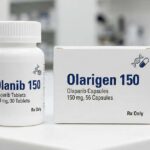PARP Inhibitors in Ovarian and Breast Cancer Treatment
What is a PARP inhibitor?
A PARP inhibitor is a cancer drug that blocks the activity of poly(ADP-ribose) polymerase (PARP), a protein crucial for DNA repair, leading to cell death in various cancers, including ovarian, breast, prostate, pancreatic, and fallopian tube cancers.
Here are some examples of PARP inhibitors:
- Olaparib (Lynparza)
- Niraparib (Zejula)
- Rucaparib (Rubraca)
- Talazoparib (Talzenna)
- Veliparib
PARP inhibitor mechanism of action:
PARP inhibitors work by blocking the activity of poly (ADP-ribose) polymerase (PARP), a protein that helps cells repair damaged DNA. Cancer cells often rely on PARP to repair their DNA, so blocking PARP can lead to cancer cell death.
PARP inhibitors can work in two main ways:
- They can block PARP from repairing single-strand DNA breaks (SSBs). SSBs are a common type of DNA damage that can occur in both normal and cancer cells. However, cancer cells are more likely to have trouble repairing SSBs because they often have mutations in genes that are involved in DNA repair.
- They can trap PARP on DNA, which can lead to the formation of double-strand DNA breaks (DSBs). DSBs are a more serious type of DNA damage that can be difficult for cells to repair. If a cell cannot repair a DSB, it may die.
PARP inhibitors are more effective in cancer cells with certain genetic mutations, such as BRCA mutations. BRCA genes are involved in DNA repair, and mutations in these genes can make cancer cells more reliant on PARP.
PARP inhibitors can be used alone or in combination with other cancer treatments, such as chemotherapy or radiation therapy. When used in combination with other treatments, PARP inhibitors can help make the other treatments more effective and reduce the risk of side effects.
PARP inhibitors in Ovarian Cancer:
Ovarian cancer is a type of gynecological tumor that is less common than cervical and breast cancer but is more malignant. Although treatment for ovarian cancer has improved over time, patients still have less than a 50% chance of survival after five years.
Poly (ADP-ribose) polymerase (PARP) inhibitors use the concept of synthetic lethality to target tumor cells with homologous recombination repair (HRR) defects, primarily the breast cancer susceptibility genes (BRCA).
PARP inhibitors capture the PARP-1 protein at the site of DNA damage, causing the accumulation of PARP-DNA nucleoprotein complexes, which leads to DNA double-strand breaks (DSBs) and cell death. PARP inhibitors have been approved for the treatment of ovarian cancer and have had successful outcomes.
However, with increased use, more attention is being given to drug resistance and side effects. Thus, further research is necessary to comprehend the mechanism of PARP inhibitors, understand drug complications, explore efficacy and prognosis markers, and address drug resistance. This review provides an in-depth analysis of the use of PARP inhibitors for ovarian cancer treatment.
PARP Inhibitor in Breast Cancer:
The Olympia trial highlights the progress made with PARP inhibitors in breast cancer treatment, suggesting potential for improvement and expanding the patient population beyond germline (BRCA)m carriers, highlighting the potential for PARP inhibitors to benefit patients with other mutations.
Four PARP inhibitors have been approved for treating four BRCA-associated cancers: ovarian, pancreatic, prostate, and breast. In ovarian cancer, they treat recurrent cancer and maintenance therapy after chemotherapy. In pancreatic cancer, they treat metastatic disease.
Two PARP inhibitors, Olaparib, and Talazoparib, have been approved for treating metastatic HER2-negative breast cancer in gBRCAm carriers. The Olympiad and EMBRACE trials showed a 60% response rate and a median duration of response of 6 months. This has led to regulatory approval and guidelines for germline genetic testing.
The Olympia trial compared adjuvant olaparib with placebo after chemotherapy and local treatment in gBRCAm carriers with HER2-negative breast cancer and high recurrence risk. Eligibility included those with residual disease after at least six cycles of neoadjuvant chemotherapy. The trial was stopped early due to the superiority observed for the olaparib arm. Olaparib resulted in significantly better invasive and distant disease-free survival, with a decrease in distant recurrences. In March 2022, a significant overall survival benefit was reported.
Recurrence Ovarian Cancer:
Ovarian cancer recurrence occurs when cancer returns after treatment, often in the pelvis, abdomen, or lungs. The risk depends on stage, type, and response. Early-stage ovarian cancer has a lower risk, while high-grade serous carcinoma has a higher risk. Symptoms include pelvic pain, abdominal bloating, difficulty eating, fatigue, weight loss, changes in bowel or bladder habits, back pain, and pain during intercourse. Treatment options include surgery, chemotherapy, radiation therapy, or targeted therapy. Working with a doctor is crucial for a personalized treatment plan.
Do PARP inhibitors work in kidney cancer treatment?
PARP inhibitors are currently not a standard treatment option for most cases of kidney cancer(Renal cell carcinoma). However, there are ongoing research efforts exploring their potential effectiveness, particularly in specific situations.
Know what are the symptoms of breast cancer and what are the diagnosis.




